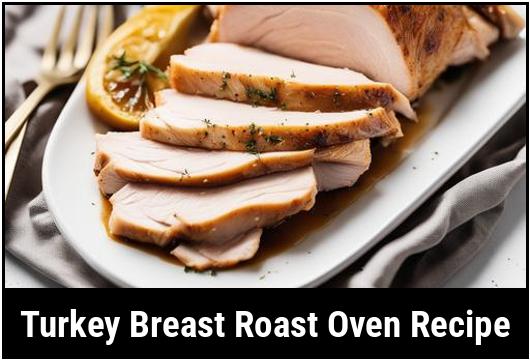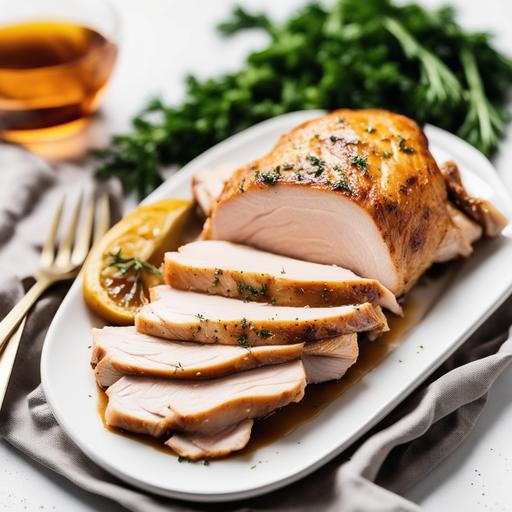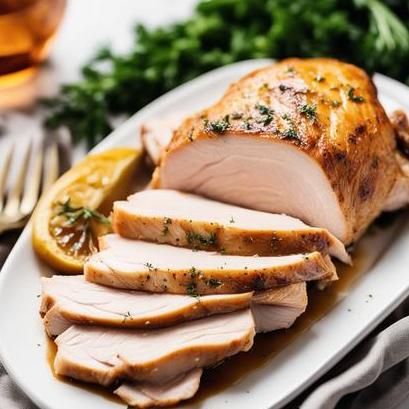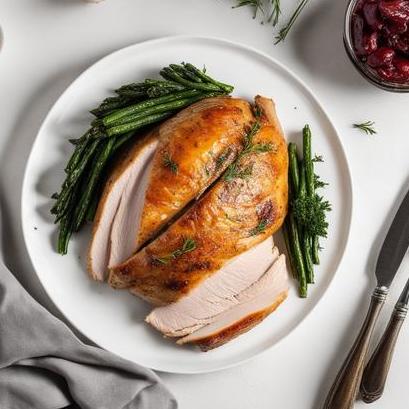
Turkey Breast Roast Oven Recipe: A Comprehensive Guide
Are you craving a succulent, juicy, and perfectly roasted turkey breast? Look no further! In this comprehensive guide, we will walk you through every step of the process, ensuring you achieve a mouthwatering turkey breast roast that will leave your guests amazed. From selecting the right cut of meat to mastering the cooking technique, we will delve into the food science, culinary details, cleaning, preparation, tips, variations, doneness checks, and the all-important recipe. So let’s get started!
Selecting the Perfect Turkey Breast
Choosing the right turkey breast is vital to achieving the best results. Look for a boneless, skin-on turkey breast weighing around 2-3 pounds for this recipe. The boneless option provides ease of slicing, while the skin helps retain moisture and imparts incredible flavor during the roasting process. Additionally, try to opt for organic or free-range turkey for a more ethical and flavorsome choice.
Cleaning and Preparing the Turkey Breast
Before cooking, it’s essential to clean and prepare your turkey breast properly. Follow these steps for a hygienic and successful cooking experience:
-
First, remove the turkey breast from its packaging and rinse it under cold water. Pat it dry thoroughly with a clean paper towel.
-
Place the turkey breast on a cutting board, skin side up, and use a sharp knife to remove any excess fat, silver skin, or undesirable bits. Trimming helps promote even cooking and enhances the visual appeal of the final dish.
-
Next, wash your hands thoroughly with soap and warm water, ensuring there’s no cross-contamination.
-
Prepare a clean workspace, as well as all the necessary seasonings, equipment, and ingredients.
Understanding the Food Science behind the Roasting Process

To achieve a perfectly moist turkey breast roast, it’s crucial to understand the food science behind the cooking process. When you place the turkey breast in the oven, several chemical reactions occur:
-
Maillard Reaction: As the turkey breast roasts, the amino acids and sugars present on the surface of the meat undergo a chemical reaction known as the Maillard reaction. This process results in the browning of the skin and the development of deep, savory flavors.
-
Collagen Breakdown: Collagen, a connective tissue found in meat, begins to break down during the cooking process. As collagen breaks down, it transforms into gelatin, contributing to the tenderness and succulence of the turkey breast.
-
Moisture Retention: The turkey breast’s skin acts as a natural barrier, helping to seal in moisture and prevent drying during cooking. Proper cooking techniques and basting also ensure the meat retains moisture and remains juicy.
Tips for a Perfectly Roasted Turkey Breast

Achieving a mouthwatering turkey breast roast requires attention to detail and a few insider tips. Follow these suggestions to take your culinary skills to the next level:
-
Brining: Brining involves soaking the turkey breast in a saltwater solution overnight, promoting tenderness, flavor infusion, and moisture retention. While optional, brining can significantly enhance your final result.
-
Seasoning: Be generous with your seasoning. Create a rub using a mix of dried herbs, spices, salt, and pepper. Gently massage the seasoning into the turkey breast, ensuring it’s evenly coated.
-
Trussing: Trussing, or tying up the turkey breast with kitchen twine, helps maintain its shape during cooking and ensures even heating.
-
Basting: Regular basting with pan juices or melted butter keeps the turkey breast moist and adds extra flavor. Baste every 30 minutes using a basting brush or a spoon.
-
Resting: Allowing the roasted turkey breast to rest for 15-20 minutes before carving is essential. This allows the juices to redistribute throughout the meat, resulting in a moist and tender final dish.
Recipe: Juicy and Flavorful Turkey Breast Roast

Now that you understand the important details let’s dive into the recipe. Follow these comprehensive instructions to achieve a turkey breast roast that will be the highlight of your meal:
Ingredients:
-
2-3 pound boneless, skin-on turkey breast
-
2 tablespoons olive oil
-
1 tablespoon dried thyme
-
1 tablespoon dried rosemary
-
1 tablespoon dried sage
-
1 teaspoon garlic powder
-
1 teaspoon onion powder
-
1 teaspoon salt
-
1/2 teaspoon black pepper
-
1 cup chicken or vegetable broth
Instructions:
-
Preheat the oven to 350°F (175°C).
-
In a small bowl, combine the dried thyme, rosemary, sage, garlic powder, onion powder, salt, and black pepper to create a flavorful rub.
-
Place the turkey breast on a clean cutting board, skin side up, and drizzle it with olive oil.
-
Sprinkle the herb rub evenly over the entire surface of the turkey breast, pressing it gently to adhere.
-
Transfer the turkey breast to a roasting pan with a rack. Pour the chicken or vegetable broth into the bottom of the pan to prevent drippings from burning.
-
Place the roasting pan on the middle rack of the preheated oven and roast the turkey breast for approximately 1 ½ to 2 hours or until the internal temperature reaches 165°F (74°C).
-
Baste the turkey breast with pan juices or melted butter every 30 minutes.
-
Use a meat thermometer to check the internal temperature. Insert the thermometer into the thickest part of the turkey breast, avoiding contact with bone.
-
Once the turkey breast reaches the desired temperature, remove it from the oven and tent it loosely with aluminum foil. Allow it to rest for 15-20 minutes before carving to preserve its juiciness.
-
Carve the turkey breast into thin, even slices and serve with your favorite side dishes.
Variations and Serving Suggestions

While the recipe above provides a classic and flavorful turkey breast roast, feel free to experiment with variations and additional ingredients to suit your taste preferences. Here are a few ideas to get you started:
-
Citrus-Herb Turkey Breast: Add fresh lemon or orange zest to the herb rub for a burst of citrus flavor.
-
Maple-Glazed Turkey Breast: Prepare a glaze using maple syrup, Dijon mustard, and a touch of cinnamon. Brush the glaze over the turkey breast during the final 30 minutes of roasting.
-
Bacon-Wrapped Turkey Breast: Wrap thin strips of bacon around the turkey breast before roasting. The rendered fat from the bacon will keep the meat moist and impart a delicious smoky taste.
Serve your turkey breast roast with traditional sides such as mashed potatoes, cranberry sauce, green beans, and gravy. You can also incorporate wild rice, roasted root vegetables, or a fresh salad to add variety and balance to the meal.
Doneness Checks and Food Safety
To ensure your turkey breast roast is cooked to perfection and safe to consume, follow these essential food safety guidelines:
-
Use a digital meat thermometer to check the internal temperature of the turkey breast, as visual cues alone may not be accurate. The thickest part of the breast should register 165°F (74°C) to indicate it’s fully cooked.
-
Insert the thermometer probe into the meat, avoiding contact with bone or the roasting pan, as these can give false readings.
-
If you’re brining the turkey breast, rinse it thoroughly before seasoning and cooking to remove excess salt.
-
Avoid leaving the turkey breast at room temperature for more than two hours to prevent bacteria growth. Proper storage and handling are crucial for food safety.
-
If you have leftovers, store them in airtight containers in the refrigerator for up to three days. Utilize them creatively in sandwiches, salads, or soups to savor the deliciousness for days to come.
With these tips, variations, and food safety precautions in mind, you are well-equipped to tackle your turkey breast roast with confidence.
Remember, practice makes perfect. Don’t get discouraged if you don’t achieve a flawless turkey breast roast on your first attempt. Each time you cook, you’ll gain valuable experience that will elevate your culinary skills and help you master this delectable dish.
So, roll up your sleeves, gather the ingredients, and embark on a culinary journey that will delight both your taste buds and those of your loved ones. Happy cooking and bon appétit!
Sources
FAQS On Turkey Breast Roast Oven Recipe
How Long Should I Cook A Turkey Breast Roast In The Oven?
The general rule is to cook the turkey breast roast for 20 minutes per pound at 350°F.
Do I Need To Brine The Turkey Breast Before Roasting?
Brining is not necessary, but it can help keep the turkey moist and add flavor. If you choose to brine, do so for 24 hours before cooking.
Should I Cover The Turkey Breast While Roasting?
It is not necessary to cover the turkey breast, but you can do so with foil for the first half of cooking to prevent the skin from getting too dark.
How Can I Ensure That My Turkey Breast Is Cooked Thoroughly?
Use a meat thermometer to check the internal temperature of the turkey breast. It should reach 165°F for safe consumption.
Can I Add Herbs And Spices To The Turkey Breast While Roasting?
Yes, you can season the turkey breast with your preferred herbs and spices before roasting to add flavor. Be careful not to over-season as this can overpower the natural flavor of the turkey.


